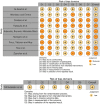A systematic review and meta-analysis of the clinical performance of implant-supported overdentures retained by CAD-CAM bars
- PMID: 37646715
- PMCID: PMC10501751
- DOI: 10.1590/1678-7757-2023-0054
A systematic review and meta-analysis of the clinical performance of implant-supported overdentures retained by CAD-CAM bars
Abstract
Currently, there is no consensus on the indications and clinical performance of implant-supported overdentures (IODs) involving computer-aided design and manufacturing (CAD-CAM) bars.
Objective: To evaluate the performance of IODs involving CAD-CAM bars.
Methodology: A comprehensive search of studies published until May 2023 was conducted in many databases, including PubMed/MEDLINE, Web of Science, Cochrane Library, and SciELO, following the Preferred Reporting Items for Systematic Reviews and Meta-Analyses (PRISMA). The population, intervention, comparison, outcome (PICO) question was: "How do IODs retained by bars fabricated by CAD-CAM technology perform in daily clinical practice?" The meta-analysis included clinical studies based on effect size and a two-tailed null test with a 95% confidence interval (CI).
Results: Ten studies were included in the meta-analysis. Among them, nine reported a 100% implant survival rate for all CAD-CAM milled bars. Complications were reported in two studies with CAD/CAM-milled titanium bars, and one study reported more fractures in soldered gold bars used in maxillary rehabilitation. However, no fractures were observed in IODs retained by PEEK and zirconia bars. According to six studies, biological complications, including peri-implantitis, were minimal in the BioHPP and PEEK bar groups, while no cases were reported in the titanium or zirconia bar groups. CAD-CAM-milled zirconia bars had higher plaque and bleeding indices compared with titanium bars, as evidenced by findings from five studies. All four studies that evaluated Oral Health Impact Profile (OHIP) scores showed a positive effect of IODs retained by CAD-CAM milled titanium bars on quality of life. Patient satisfaction and acceptance by prosthodontists were significantly high, according to the results of five studies.
Conclusion: Overdentures retained with CAD-CAM milled titanium bars show great potential for use in daily clinical practice. Moreover, patient and practitioner satisfaction was very high when this method was used.
Conflict of interest statement
The authors declare no conflict of interest.
Figures






References
-
- Emami E, Heydecke G, Rompré PH, Grandmont P, Feine JS. Impact of implant support for mandibular dentures on satisfaction, oral and general health-related quality of life: a meta-analysis of randomized-controlled trials. Clin Oral Implants Res. 2009;20(6):533–544. doi: 10.1111/j.1600-0501.2008.01693.x. - DOI - PubMed
-
- Behneke A, Behneke N, d’Hoedt B, Wagner W. Hard and soft tissue reactions to ITI screw implants: 3-year longitudinal results of a prospective study. Int J Oral Maxillofac Implants. 1997;12(6):749–757. - PubMed
-
- Jemt T, Chai J, Harnett J, Heath MR, Hutton JE, Johns RB, Herrmann I. A 5-year prospective multicenter follow-up report on overdentures supported by osseointegrated implants. Int J Oral Maxillofac Implants. 1996;11(3):291–298. - PubMed
-
- Feine JS, Carlsson GE, Awad MA, Chehade A, Duncan WJ, Gizani S, Wismeijer D. The McGill consensus statement on overdentures. Mandibular two-implant overdentures as first choice standard of care for edentulous patients. Int J Oral Maxillofac Implants. 2002;17(4):601–602. - PubMed
Publication types
MeSH terms
Substances
LinkOut - more resources
Full Text Sources
Miscellaneous

